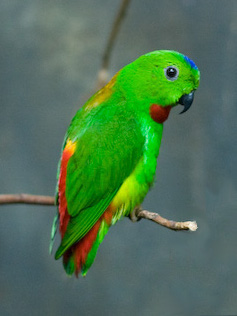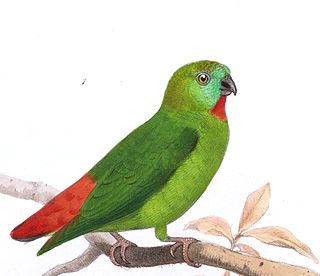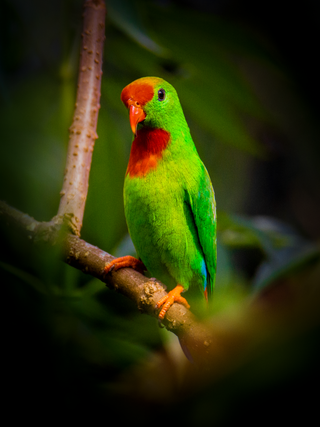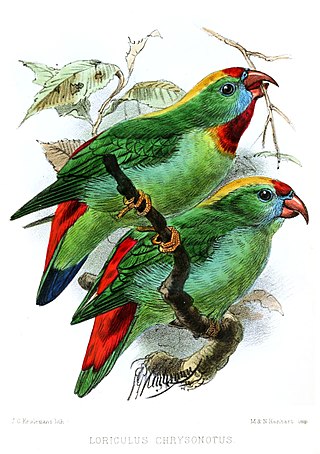
Lovebird is the common name for the genus Agapornis, a small group of parrots in the Old World parrot family Psittaculidae. Of the nine species in the genus, all are native to the African continent, with the grey-headed lovebird being native to the African island of Madagascar.

Hanging parrots are birds in the genus Loriculus, a group of small parrots from tropical southern Asia.

The blue-crowned hanging parrot is a parrot species endemic to southern Burma and Thailand, Malaya, Singapore, and Indonesia. These parrots are 12cm in height and weight 28g and have a longevity of 14 years. They are recognized by their green plumage, black beak and characteristic blue feathers arranged like a crown on their head.

The rosy-faced lovebird, also known as the rosy-collared or peach-faced lovebird, is a species of lovebird native to arid regions in southwestern Africa such as the Namib Desert. Loud and constant chirpers, these birds are very social animals and often congregate in small groups in the wild. They eat throughout the day and take frequent baths. Coloration can vary widely among populations. Plumage is identical in males and females. Lovebirds are renowned for their sleep position in which they sit side-by-side and turn their faces in towards each other. Also, females are well noted to tear raw materials into long strips, "twisty-tie" them onto their backs, and fly substantial distances back to make a nest. These birds are common in the pet industry.

Fischer's lovebird is a small parrot species of the genus Agapornis. They were originally discovered in the late 19th century. They are named after German explorer Gustav Fischer.

The yellow-collared lovebird, also called masked lovebird, black-masked lovebird or eye ring lovebird, is a monotypic species of bird of the lovebird genus in the parrot family Psittaculidae. They are native to Arusha Region of Tanzania and have been introduced to Burundi and Kenya. Although they have been observed in the wild in Puerto Rico, they are probably the result of escaped pets, and no reproduction has been recorded. They have also been observed in Arizona.

Psittacinae is a subfamily of Afrotropical or Old World parrots, native to sub-Saharan Africa, which include twelve species and two extant genera. Among the species is the iconic grey parrot.

The red-headed lovebird also known as the red-faced lovebird is a member of the genus Agapornis, a group commonly known as lovebirds. Like other lovebirds it is native to Africa.

The black-cheeked lovebird is a small parrot species of the lovebird genus. It is mainly green and has a brown head, red beak, and white eyerings. It is endemic to a relatively small range in southwest Zambia, where it is vulnerable to habitat loss.

The gray-headed lovebird or Madagascar lovebird is a small species of parrot of the lovebird genus. It is a mainly green parrot. The species is sexually dimorphic and only the adult male has grey on its upper body. They are native on the island of Madagascar and are the only lovebird species which are not native on the African continent. They are the smallest of the lovebird species. It is rarely seen in aviculture and it is difficult to breed in captivity.

The black-winged lovebird also known as Abyssinian lovebird is a mainly green bird of the parrot family. At about 16.5 cm (6.5 inches) long, it is the largest of the lovebird genus, a group of small parrots. The adult male is easily identified by its red forehead, and the adult female by its all-green head. They are native to Eritrea and Ethiopia, and they are uncommon as pets.

The black-collared lovebird also known as Swindern's lovebird is a small, 13.5 cm (5 in) long, African parrot in the genus Agapornis. It is a mostly green parrot with black band on the back of its neck, and a dark greyish-black bill. Both sexes are similar. It is rarely kept in captivity because of its dietary requirement for a native fig.

The guaiabero is a species of parrot in the family Psittaculidae, belonging to the monotypic genus Bolbopsittacus and closely related to the lovebirds (Agapornis) and hanging parrots (Loriculus). It is endemic to the Philippines and locally known as bubutok. Its common name is derived from its reputation for eating guavas.

The orange-fronted hanging parrot or Papuan hanging parrot is a small species of parrot in the family Psittaculidae. It is endemic to forest in New Guinea and adjacent smaller islands. It sometimes includes the Bismarck hanging parrot as a subspecies.

The Philippine hanging parrot, also commonly known as the colasisi from its local Tagalog name "kulasisi", is a small psittaculid parrot species endemic to the Philippines. It includes about eleven subspecies, at least one of which might represent a distinct species, although further research is needed. While it is listed as Least Concern in IUCN, some subspecies, such as L. p. chyrsonotus of Cebu and L. p. siquijorensis of Siquijor, may already be extinct. The species is threatened by habitat loss, but a bigger threat is trapping for the illegal wildlife trade; wild-caught birds are often sold as pets in streets and online selling groups.

The great hanging parrot, also called Celebes hanging parrot, Sulawesi hanging parrot and maroon-rumped hanging parrot, is a species of parrot in the family Psittaculidae. It is endemic to Sulawesi and nearby smaller islands in Indonesia, where it occurs in forest, secondary growth and tall mangrove.

The Bismarck hanging parrot or green-fronted hanging parrot is a small species of parrot in the family Psittaculidae. It is endemic to forest in the Bismarck Archipelago in Papua New Guinea. It is threatened by habitat loss. It is sometimes considered a subspecies of the orange-fronted hanging parrot.

The Camiguin hanging parrot is a hanging parrot endemic to the Philippine island of Camiguin, where its habitat is diminishing. The taxonomy of this population of parrots on Camiguin is uncertain.

The Cebu hanging parrot is a subspecies of the Philippine hanging parrot found only on the island of Cebu, Philippines. This subspecies was generally believed to be extinct until an expedition led by the Department of Environment and Natural Resources (Cebu) claimed to have seen and captured a tiny bird in thick foliage in the remote part of central Cebu. The bird has a distinctive scarlet tail with faint patches of red on its head. Females lack the red throat and breast patch, as opposed to males. The nape and upper back are green-tinged and only lightly golden-yellow. They have a high-pitched, whistle-like sound. The bird measures 14 cm (5.5 in) long with a wingspan of 18 cm (7 in).

The black-billed hanging parrot is a hanging parrot native to the Sulu Archipelago of the Philippines.




















